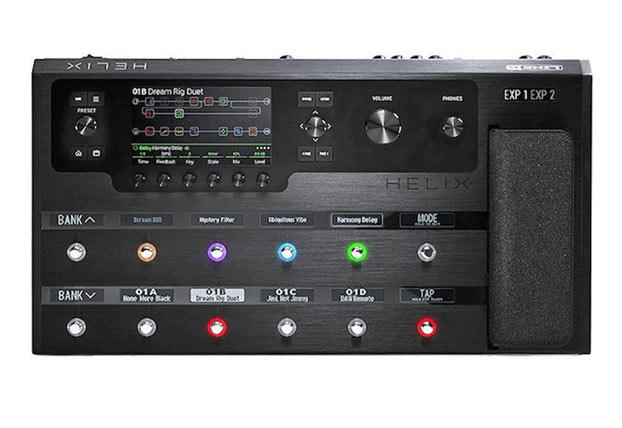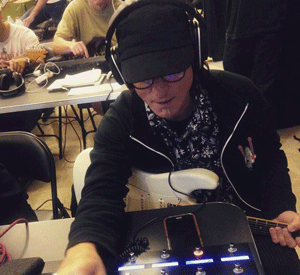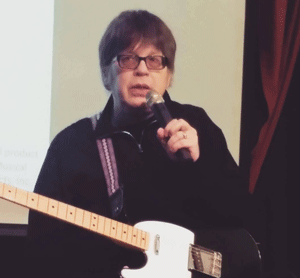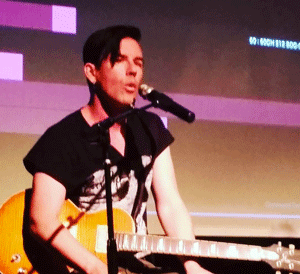What Line 6's 20 Years of Innovation Means to Guitarists

In 1991, while working as an editor of Electronic Musician, something happened that not only revolutionized the recording industry, it also ensured the rampant success of the magazine’s “personal studio for musicians” mantra.
The Alesis ADAT—with future Line 6 co-founder Marcus Ryle on the design team—was a relatively affordable marvel ($3,995 each at the time, as opposed to tens of thousands for other digital recorders) that put stunning audio quality in the hands of just about any musician with a desire to control their own musical destiny.
It might be hard to realize how huge that innovation was when, today, even our smartphones have digital multitrack apps, but it jump-started an entire industry of musician-run, small “boutique” and home studios that could compete (somewhat) with big and expensive commercial studio facilities. Freedom!
Five years later, Ryle and his team had started Line 6, and another soon-to-be-world-changing innovation appeared at the Electronic Musician office: the AxSys 212 digital-modeling amplifier. It was a somewhat controversial product at the time, as it triggered a storm of digital vs. tube debates amongst guitarists that continued for far too long.
And then, in 1997, came POD.
The cute, kidney-shaped red box was a digital amp and cabinet modeler with direct-recording outputs that found favor with producers, engineers, and guitarists everywhere. It’s hard to say how many hit songs and other tracks were recorded with some level of POD guitar tones, but it had to be a MASSIVE number, as POD sat on just about every mixing console in every studio—personal or professional—in the known world.
The AySys 212 and POD birthed an ever-evolving line up of cool digital products for guitarists (and other musicians). This is certainly a boon for me professionally, as I joined Guitar Player as its editor-in-chief in 1998, and Line 6 always provided interesting, game-changing, bizarre, or inspirational gear for the magazine to review. Some of my personal favorites were the Stompbox Modelers (DL4, MM4, DM4, FM4, AM4), Bass POD, GuitarPort, Variax 500 (which we put on the July 2003 cover of Guitar Player), Variax Acoustic, Variax Workbench, TonePort UX2, POD X3 Live, M13 Stompbox Modeler, Alchemist 112, Relay G50, StageSource system with StageScape M20d, AMPLIFi 75, Spider V 60 (wireless ready!), and Helix.
Get The Pick Newsletter
All the latest guitar news, interviews, lessons, reviews, deals and more, direct to your inbox!
For a timeline of all Line 6 products from 1996-2016, click here.
TONE MADE PRO AND THE FUTURE OF GUITAR SOUND
Taking the Tone Made Pro seminar.

Starting in 2016, Line 6 launched a “Tone Made Pro” initiative around the Helix, with supporting seminars to teach users about the construction of classic guitar tones, but, more importantly, how to use the Helix to create an individual guitar sound. Obviously, these types of educational programs are “music to my ears” (sorry about the cliché), because as the editor of a guitar magazine and an evangelist for the guitar, I want players to explore stranger, unique, and more personal guitar tones. We need to get to the next level of tone and texture to drive modern music and keep people thrilled and seduced by today’s guitar players.
I even took a seminar myself on August 25, 2016, at Line 6 headquarters with a room full of Helix users. I think 99.9 percent of the attendees were already well-versed with Helix operations—the 0.1 percent being me. I hadn’t had a chance to use the Helix before the seminar. However, the instructors were extremely helpful, so I could keep up with my “classmates.”
The seminar began with detailed explanations of Helix presets of classic guitar rigs, which was a great way for all to understand the various building blocks of tones. Then, the first special guest, Elliot Easton, stepped out to play some of his killer solos on hits for the Cars using the dedicated Helix presets for each song.
Elliot Easton
Later on, Pete Thorn demonstrated how he crafted his personalized guitar tones for the stage and studio. In essence, it was a very cool class in how to mess with convention until you find what’s yours alone. As a result, the Tone Made Pro seminar took a very savvy adventure from detailing the conventional elements of classic guitar tone to showcasing options for utilizing the Helix’s processing to sound different.
Pete Thorn
To me, this is the culmination of all of Line 6’s innovations and products—to vaporize any impediments to crafting the sounds you love, in order to make your music as much of a personal statement as it can be. I say—“Own Your Tone!”


Line 6 Helix in Action in the Studio
“Even the thought that Clapton might have seen a few seconds of my video feels surreal. But I’m truly honored”: Eric Clapton names Japanese neo-soul guitarist as one to watch
“You better be ready to prove it’s something you can do”: Giacomo Turra got exposed – but real guitar virtuosos are being wrongly accused of fakery, too










